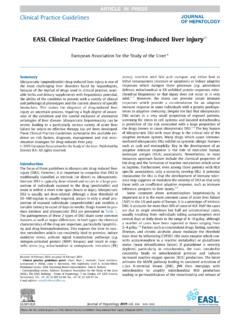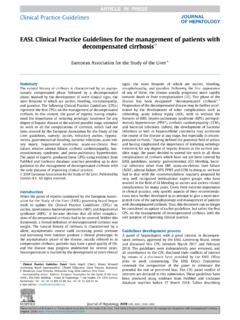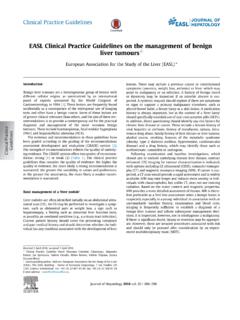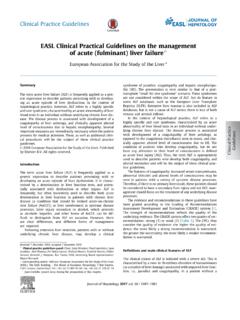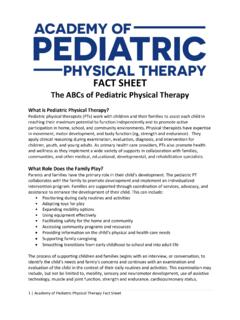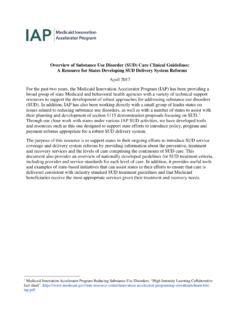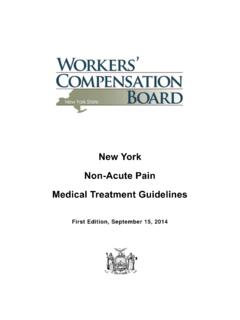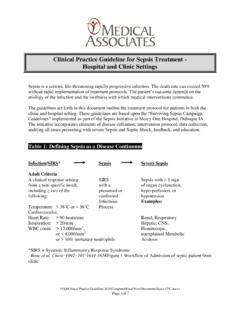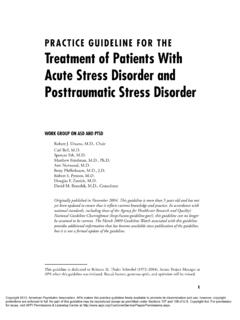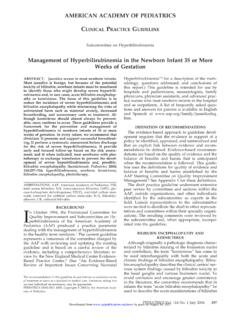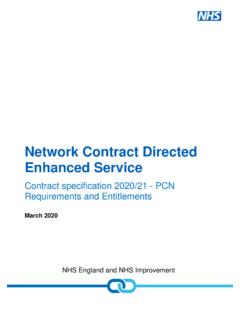Transcription of EASL Clinical Practice Guidelines: Autoimmune hepatitisq
1 EASL Clinical Practice guidelines : Autoimmune hepatitisqEuropean Association for the Study of the Liver IntroductionAutoimmune hepatitis (AIH) was the first liver disease for whichan effective therapeutic intervention, corticosteroid treatment,was convincingly demonstrated in controlled Clinical , 50 years later AIH still remains a major diagnosticand therapeutic challenge. There are two major reasons for thisapparent contradiction: Firstly, AIH is a relatively rare , AIH is a very heterogeneous other rare diseases, Clinical studies are hampered by thelimited number of patients that can be included in trials. Possiblyand more importantly, the interest of the pharmaceutical indus-try to develop effective specific therapies for rare diseases is lim-ited due to the very restricted market for such products.
2 The wideheterogeneity of affected patients and Clinical manifestations ofthe disease limits both diagnostic and further therapeutic s age spectrum is extremely wide, it can affect small infantsand can manifest for the first time in octogenarians. AIH can run avery mild subclinical course or be very acute , rarely leading tofulminant hepatic failure. AIH sometimes demonstrates quitedramatic disease fluctuations with periods of apparent sponta-neous remissions, acute flares and/or smouldering disease. AIHcan be associated with a number of other hepatic conditions, inparticular the cholestatic liver diseases; primary biliary cirrhosis(PBC) or primary sclerosing cholangitis (PSC), but also withdrug-induced liver injury (DILI), alcoholic or non-alcoholicsteatohepatitis (NASH) or viral hepatitis.
3 Each condition providesspecial diagnostic and therapeutic challenges. Despite these chal-lenges and complexities, diagnosis and treatment of AIH has seenstriking progress, and now patients in specialised centres have anexcellent prognosis, both in respect to survival and to quality aim of the present Clinical Practice Guideline (CPG) is toprovide guidance to hepatologists and general physicians in thediagnosis and treatment of AIH in order to improve care foraffected patients. In view of the limited data from large con-trolled studies and trials, many recommendations are based onexpert consensus. This is to some extent a limitation of thisEASL-CPG, but at the same time it is its special strength: consen-sus in this guideline is based on intensive discussions of expertsfrom large treatment centres.
4 The core consensus group hasexperience of over one thousand AIH patients managed person-ally, and the recommendations have been reviewed by both theEASL Governing Board as well as external experts, who have asimilarly wide personal experience. Therefore, the guidelinesare a resource of information and recommendations based onthe largest experience available thus far. At the same time, weformulate key scientific questions that result from the consensusdiscussions on the limitations of our knowledge. All recommen-dations of this CPG were agreed upon unanimously (100%) con-sensus. Grading of the recommendations is based on theGRADE system for evidence (Table 1) [1].Epidemiology of AIHAIH is an non-resolving chronic liver disease that affects mainlywomen and is characterized by hypergammaglobulinaemia evenin the absence of cirrhosis, circulating autoantibodies, associationwith human leukocyte antigens (HLA) DR3 or DR4, interface hep-atitis on liver histology, and a favourable response to immuno-suppression [2 5].
5 The disease, if untreated, often leads tocirrhosis, liver failure and is considered relatively rare, as its prevalence ranges from16 to 18 cases per 100,000 inhabitants in Europe [6 11]. Untilrecently, the incidence and prevalence of AIH on a population-based level was assessed in only two studies [6,9]. Interestinglyhowever, higher prevalence rates have been reported in areaswith quite stable populations. For instance, prevalence rates cases per 100,000 and cases per 100,000 inhabitantshave been reported in Alaska natives [12] and New Zealand [9],respectively. In addition, a large Danish nationwide population-based study assessed the incidence and prevalence of AIH inDenmark during a nearly 20 year time period ranging from1994 to 2012 including 1721 AIH patients [13].
6 The most strikingobservation in that study was the marked increase in AIH inci-dence over time, which could not be attributed to a relativeJournal of Hepatology2015vol. 63j971 1004 Received 30 June 2015; accepted 30 June 2015 Chairman:Ansgar W. members:Olivier Chazouill res, George Dalekos, Joost Drenth, MichaelHeneghan, Harald Hofer, Frank Lammert, Marco Lenzi. Correspondence: EASL office, 7 Rue Daubin, CH 1203 Geneva, : +41 22 807 0360; fax: +41 22 328 American College of Gastroenterology; AGA, AmericanGastroenterological Association; ANCA, Antineutrophil cytoplasmic antibodies;APECED, Autoimmune polyendocrinopathy-cadidiasis ectodermal dystrophy; AS, acute severe Autoimmune ; CNI, Calcineurin inhibitor; CPG, Clinical PracticeGuideline; DEXA, Dual energy x-ray absorptiometry; DILI, Drug-induced liverinjury; HAI, Hepatitis activity index; HBV, Hepatitis B virus; HLA, Humanleukocyte antigens; HRQoL, Health related quality of life; IBD, Inflammatorybowel disease; IgG, Immunoglobulin G; LBR, Live birth rate; LT, Livertransplantation; MMF, Mycophenolate mofetil.
7 MRCP, Magnetic resonancecholangiopancreatography; NAFLD, Non-alcoholic fatty liver disease; NASH,Non-alcoholic steatohepatitis; PBC, Primary biliary cirrhosis; PROM, Patientreported Outcome Measures; PSC, Primary sclerosing cholangitis; SCBU, Specialcare baby unit; SMA, Smooth muscle antibodies; TPMT, Practice Guidelineschange in case ascertainment rates. Actually, the incidence rate ofAIH in Denmark has nearly doubled between 1994 to 2012,reaching a point prevalence in 2012 of 24/100,000 (35/100,000for females) [13].AIH prevalence and Clinical expression seem to vary accordingto ethnicity. Alaskan natives appear to have a high frequency ofacute icteric disease at the disease onset [12], and the diseaseis more common and more severe in North AmericanAboriginal/First Nations populations compared with predomi-nantly Caucasian, non-First Nations populations [14].
8 African-American patients more commonly have cirrhosis, a higher fre-quency of treatment failure and higher mortality than whiteAmerican patients [15,16]. Mexican Mestizos commonly showcirrhosis at initial evaluation [17] and patients of Hispanic originare characterized by an aggressive presentation both biochemi-cally and histologically with a very high prevalence of cirrhosisand cholestatic features [18,19], whereas patients of Asian orother non-European Caucasoid background have very poor out-comes [18,20]. Although most of the above mentioned studiesare retrospective and have been performed in tertiary centres,these observations have led to the assumption that AIH hasdiverse Clinical phenotypes and outcomes in different ethnicgroups within a country and between countries.
9 These differ-ences may reflect genetic predispositions, indigenous etiologicalagents, and/or pharmacogenomic mechanisms, but they mightalso be primarily due to complex socioeconomic reasons suchas variations in the delivery of health care , delayed diagnosis aswell as competing risk factors [21]. of AIH ranges from 15 to 25 cases per 100,000 inhabitants in Europe and is increasing in both women and men (II-2)AIH can affect all populations and all age groups (II-2) Clinical spectrumClinical features of AIHIn the early 1950s, a novel type of chronic hepatitis with severalparticular features, such as a predilection for young women, aprogressive and usually fatal outcome accompanied by arthralgia,endocrine dysfunction, cutaneous striae and acne, and very highlevels of immunoglobulins in the serum that correlated with anexcess of plasma cells in the liver, was reported firstly by theSwedish physician Jan Waldenstr m [22] and later by Kunkelet al.
10 [23]. In 1955, the lupus erythematosus cell phenomenonwas demonstrated in these patients and therefore, the term lupoid hepatitis was introduced by the group of Ian Mackayin 1956 [24], but ten years later this term was replaced by Autoimmune hepatitis [25], which after a variety of differentterms was accepted in the 1990s by the International AIHG roup (IAIHG) as the final one [26].It is now well established that AIH is a clinically distinct syn-drome characterized by a large heterogeneity of Clinical , labora-tory and histological manifestations (Table 2). Therefore, AIHshould be considered in any patient with acute or chronic liverdisease, particularly if hypergammaglobulinemia is present, andif the patient has features of other Autoimmune diseases(Table 3) [2 4,26 28].
